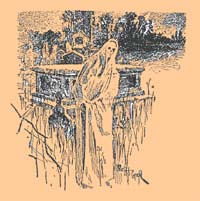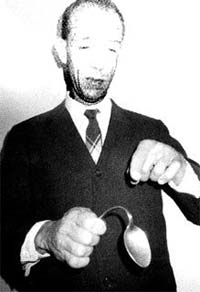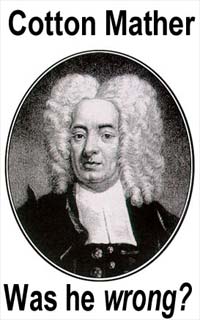
This is Part Two of the Sagan/Whiteside article, "A Skeptical View of 'The Sciences of Complexity.'" A few of you have expressed difficulty getting through Part One, but on the whole there has been acceptance and even delight expressed by readers. In fact, reader reaction has been very heavy, which indicates that there's interest on the page for such matters. Enjoy!
Error of the Term "Self-Organization," All-Natural Purpose and a New, Thermodynamic Explanation of "Ghosts"

Without a knowledge of the thermodynamic genesis of complex systems (for example, if you have too deep a dependence on natural selection to explain complexity), you open yourself up to misinterpreting natural process for design, conspiracy, miraculous coincidence, divine intervention or some other creationistic or mystical ordering principle. As in the tale of Goldilocks and the Three Bears, where the temperature of the porridge must be "just right" — not too hot or cold — to be devoured, so complex open thermodynamic systems only occur when the temperature or other gradient is just right (described in hydrodynamics by non-dimensional numbers). These phase transitions seem to self-organize and, more rarely, achieve autonomy, but their order does not come for free, it is energized by the non-equilibrium environment. In Bénard cells, which also form on the surface of the sun, the organizing gradient is literally a temperature gradient across a viscous fluid, sometimes spermaceti, sperm whale oil. The complex pattern of hexagonal cells works from the top down, macro-to-micro level, a "self-organization" of trillions of atoms simultaneously, to coherently reduce a gradient across a fluid. Although we criticize the concept of self-organization, the glimmer of selfhood arising can be seen in the natural differentiation of fluid constituents from a gradient-divided (and from the statistical mechanical vantage point of random interactions, highly improbable) background.The gradient-organized continuous whirlpool, properly named Whirlpool, downstream of Niagara Falls, is an example of incipient selfhood. So are the cycling storm systems of hurricanes, tornadoes, and twisters, also not coincidentally given names, whose forcefulness and persistence correlate to the barometric or air pressure gradient that sustains them. Belousov-Zhabotinsky reactions become locally more complex as long as they are fed the reagents that form a chemical concentration or electron potential gradient; the behavior of many molecules comes into concert, becomes coherent, and the colored chemical, looking more like life or art, displays a variety of organized patterns. Spinning a cylinder inside another will cause pairs of counter-rotating whirlpools, called Taylor vortices, to appear; the number of pairs jump and, as the pressure gradient increases or decreases, display a sort of non-genetic history or memory. Although true selfhood as we know it (from the inside) comes in cells and living beings such as ourselves made of cells, including brain cells able to model and remember, selfhood exists along continuum. Indeed, even the purposeful behavior that seems to separate humanity or higher life forms from lower life or inanimate processes, may have a (non-equilibrium) thermodynamic explanation. It may be the natural end of a rubber ball to reduce its potential energy (collapse the gravitational energy gradient) and fall to the ground, but to speak of its purpose as such sounds silly. However, transforming energy into structure and work cycles within organisms, energy that is stored and redeployed at a later time, describes the overall metabolic purpose of organisms — organisms sometimes differentiated into tissues and organs such as lungs and heart, with physiological purposes. Given that our conscious purpose is secondary to the physiological know-how entailed by staying alive (as open, non-equilibrium, thermodynamic systems), our vaunted purpose may be an epiphenomenon or elaboration of nature's inanimate thermodynamic goal, to come to equilibrium.
Often, conscious human goals to eat and have sex, accumulate wealth and be liked, reflect metabolic and reproductive imperatives that themselves prolong the existence of complex systems away from equilibrium, stable vehicles of degradation. Although scientifically lamented, purposeful language (e.g., the ubiquitous prepositions "to" and "for") likely reflects our orientation as complex cyclical beings dependent upon a continuous deferral of thermodynamic equilibrium. Such purpose thus does not belong to us alone. Consider a heated mounted cabin on a snowy mountain. The behavior of heat within appears to "seek" specific routes of escape. If a rug is curled to prevent leakage around a door jamb, for example, heat may escape by an alternate route through a key hole or window fitting. Here we can glean an inanimate intelligence of nature, trying with seeming purpose to come to equilibrium. And we may also glean the origin of ghosts.

The creaking of heated houses with the coming of night (the time of ghosts) is associated with an increase in temperature gradient from inside the house to outdoors. Streamers of warmer air (more likely to contain vaguely visible dust in older houses) can be expected to head toward the exits during such times. If viewed fleetingly by people, they could occasionally be sensed both tactilely and visually as ghosts. (The supposed ability to morph through a keyhole is also consonant with this view.) Indeed, those who insulate houses, broadcasting fine powders into the air in order to see its subtle movements, sometimes witness exceedingly "purposeful" movements: a given parcel of warm air may even "change its mind," going up a wall, across a ceiling, and down an opposite wall, only to reverse directions back whence it came, to head through the spaces of an electric outlet.With such movement, no doubt completely unconscious, occurring in even simple non-equilibrium systems, it is little wonder that far more complex non-equilibrium systems, maintaining and reproducing themselves as they continue to provide stable areas for gradient degradation (inevitably polluting, excreting and adding to molecular chaos in the areas around their selves), also evince purpose. Purpose, associated with conscious humans and divine design, may in other words be completely natural with a physical basis. Gradient-reducing processes and structures require neither consciousness nor natural selection either to exhibit purpose or, in the materials-limited neighborhood of a persistent gradient, build up cycles. In life, these cycles, biochemical and molecular, produce metabolism, physiology and reproduction. But the thought experiment of the first cell (not yet reproduced) shows that such complexity does not depend entirely on natural selection, which always requires reproduced variants; reproduction, rather, is a specific product of thermodynamic complexity and gradient breaking.
In nature, above and below certain threshold values, representative of the intensity of gradients, complex structures disappear. Without mysticism, without oversight, we can see how nature comes together in organized fashion in order to reduce gradients. This "in order to" is what sometimes gives the appearance of a thoughtful, humanlike teleology — or divine design — when in fact it is determined by the natural drive toward disorder inherent in the second law. Moreover, this disorder is not a simulation, the deterministic chaos algorithmically churned out by computer programs, but chaos as incalculable randomness. In the production of this atomic or molecular chaos, real (not two-dimensional computer simulations) complex entities come swirling into being.
Physicist Sir Arthur Eddington wrote that the second law of thermodynamics
. . . holds the supreme position among the laws of Nature. If someone points out to you that your pet theory of the universe is in disagreement with Maxwell's equations — then so much the worse for Maxwell's equations. If it is found to be contradicted by observation — well, these experimentalists do bungle things sometimes. But if the theory is found to be against the Second Law of Thermodynamics, I can give you no hope: there is nothing for it but to collapse in the deepest humiliation.The problem with Kauffman's attempts in "Investigations" to derive a fourth law of thermodynamics that apply especially to life (or "biospheres") — life moves as rapidly as possible into the "adjacent possible," he suggests — is the special privilege that such a law would accord to life as a process. Living matter is more complex than its inanimate cousins, and the second law-derived build-up of cycles of structural and behavioral variation has arrived at the intelligence to consciously search for new energy sources. But living matter differs in degree, not in kind, from its non-equilibrium kin.
The Cosmic Context
This drive toward chaos in the older physical sense unrelated to repeated computer instructions, is really a drive toward increasingly probable arrangements over time. The appearance of order — of organized process — is thus like a magic trick where the effect depends on the magician not showing you the entire situation. Observed in a vacuum, a Bénard cell or vortex — or a life form — seems miraculous. But these complex forms do not appear in a vacuum. Improbable as they are, they appear from still less probable antecedents. Astronomer Chaisson argues persuasively that 100,000 years after the Big Bang, entropy reached a maximum in an era of radiation. At this time, we add, the sky would have been white, because universal expansion had not yet arrived at a point producing cold sinks for radiating stars. Indeed stars — themselves organized, low entropy structures — had not yet formed. When they did, due to gravity, there began what Chaisson calls a "matter era," one rich in the temperature and other gradients that would spawn complexity — from spiraling galaxies (perhaps whirling around black holes) to planets and DNA-strewn cells packed into brains. Complexity, including human complexity, depends on energy to maintain it, and not only obeys the second law but aids and abets it by forming (within constraints) complex gradient-destroying systems when and where it can.
Not all the details are in yet, but a fascinating new adventure, a deep understanding of the role of energy in life, has begun. Complex processes do not mean complex designs, unless by "designs" we mean previously still more complex conditions. Just as Darwin linked us to other organisms through time, the second law links us to flames, Bénard cells and other inanimate systems. And these systems may display behavior so seemingly complex and orchestrated, that ordinarily (and indeed, even here) hard-nosed and skeptical scientists have been misled into dismissing the evidence for what they mistook as impossible, rather than accepting it and seeking an alternate explanation for complexity.
One good example comes from atmospheric chemistry. Oxygen is a very reactive gas and should eliminate other gases in our atmosphere such as methane. Instead, our entire atmosphere is in a highly improbable, far-from-equilibrium situation. And the reason is not hard to understand: the improbable gradient between Earth and Sun has built up on Earth (mostly through photosynthesis) into the chemical thermodynamic dis-equilibrium of an atmosphere in a "metastable" state of both hydrogen-rich gases and free oxygen. The impossibility is something like the card trick invented by magician Paul Curry, called "Out of this World." In this trick, a spectator sorts out cards, red and black, without looking at them, trying to exercise ESP. The outcome, of all correct cards, seems evidence of ESP — although it could also be ascribed to near-miraculous luck.
When zoologist Richard Dawkins and Canadian biologist W. Ford Doolittle learned of Earth's atmospheric dis-equilibrium, and heard of British atmospheric chemist James Lovelock's proposal that somehow organisms were optimizing the global environment for their own survival (the "Gaia hypothesis"), they dismissed the phenomenon as impossible, the result of mysticism, perhaps some hopelessly anthropomorphic global conspiracy among organisms. Dawkins, trotting out the old adaptationist horse and (with a narrow view of evolution through "selfish genes") argued that Earth's atmosphere could only be chemically regulated — the biosphere could only show elements of a physiology — if it had been in competition with other, less physiological planets that died out; since the Solar System was not strewn with such non-adapted carcasses, any theory of planetary physiology must be highly suspect. But Bénard cells, too, have a kind of physiology, appearing only within a certain steepness of energy gradient: too steep, or not steep enough, and no complex process — just right, — forms. Lovelock used a computer model to show how daisies, doing nothing but reflecting light, and growing in a certain temperature range, could "organize" the behavior of an entire planet.
Lovelock's Daisy World essentially showed behavior that smart scientists thought could only result from long natural selection or conscious design. But it would be more correct to say that our consciousness and purposeful behavior results from such natural behavior of energy systems. The magic of nature is thus better illuminated not by mathematical gobbledygook or formulae more complex than the phenomena they purport to explain, but by a drive toward simplicity in explanation, a drive connecting us to the universe of which we are a part.
Acknowledgments
The authors would like to thank Eric D. Schneider for his steadfast work, good humor, and encouragement.
References:
Glashow, Sheldon, 1983. Cited in "Nobel Laureate Glashow: U.S. passes torch to other hands," Brookline Chronicle Citizen, January 13, 1983, pp. 4-5.
Chandrasekhar, S., 1961. Hydrodynamic and Hydromagnetic Stability. Oxford, Clarendon Press.
Chaisson, Eric, 2001. Cosmic Evolution: The Rise of Complexity in Nature. Harvard University Press.
Kauffman, Stuart, A., 2000. Investigations. Oxford University Press.
Koschmieder, E.L., 1993. B nard Cells and Taylor Vortices, Cambridge University Press
Sagan, D., 2000. The Goldilocks Paradox: Thermodynamics and Gaia. Abstracts Guide, 2nd Chapman Conference on the Gaia Hypothesis, American Geophysical Union, Valencia, Spain, 19-23 June, p. 41
Sagan, D. and Schneider, Eric D., 2000. The Pleasures of Change. The Forces of Change: A New View of Nature, National Geographic, Washington, D.C., pp. 115-126.
Schneider, E. & Kay, J. (1994) Life as a Manifestation of the Second Law of Thermodynamics. Mathematical and Computer Modeling, 19, 6-8: 24-48.
Randi here again. Yes, they were tough going, these two parts of the Sagan/Whiteside contribution. But the rewards of solving the text and following its delicious application to the "real" world as most of us know it, can be sufficient to the job. We are grateful for the authors' generosity in sharing these thoughts with SWIFT readers.
Moti Ben-Ari has sent us a translation of an item that appeared in a recent "Yediot Aharonot" newspaper:

Oren Zerif was stopped on the Tel-Aviv-Jerusalem highway by a traffic cop and issued a summons for not wearing a seat belt. At his trial, his lawyer claimed that Zerif had supernatural powers that caused the clasp on the seat belt to bend, and that the belt had unbuckled by itself and could not be re-buckled. The prosecutor personally investigated and recommended that the charges be dropped, because: "I observed (under favorable conditions) Mr. Oren Zerif's ability to change the shape of metal objects. According to my best judgement and understanding, I assert that the phenomenon is real, without a suspicion of magic or illusion."
Gee. If I ever get into a traffic infraction in Israel, I'll try to get that prosecutor and judge on my case. They're really perceptive, right? How embarrassing for the Israeli system of justice! But hold on. Are we any less silly here in the USA? I think not. We've had judges using astrology in the courtroom, and in one case in which I was called in as an expert witness, the judge declared before the open court, at the beginning of the hearing, that he knew that ESP and psychic healing powers had been "proven" by science, and that he would therefore not entertain any doubt of such matters in the proceedings. (The "psychic" who brought the case, lost, and was heavily fined and assessed costs for her bizarre behavior. She didn't see that coming....)
Here's an interesting item. In spite of the bad spelling and grammar (corrected here), the non-existence of the site's claimed author's e-mail address, and the fact that neither of the sources given can be found, there just might be something here. I ask readers to look around and investigate for me....
It's reported that in Russia, in the Spring of 1953, an unknown "psychic" named Dimitri Polovov began a series of lectures and public demonstrations in East Berlin on ESP. Using the usual line of patter, that everyone had these abilities but that they were latent, Polovov was moderately successful, though — mysteriously! — there seems to be no record of him in the media of the period. Also in line with the standard claim, he told his audiences that by using techniques designed by him, they too could master these wondrous powers. And his most effective and original feat was his ability to bend a metal spoon by holding it between his thumb and forefinger and concentrating on it! At this time, Uri Geller was seven years old....
 What appears here is what is claimed to be the "only known photograph" of Polovov — which makes me even more suspicious, since such folks are hardly shy. Soon, we're told, he had students who were vying for a chance to learn his techniques, and a year later he had attracted the attention of the local government, who suddenly banned further appearances and took the performer into custody.
What appears here is what is claimed to be the "only known photograph" of Polovov — which makes me even more suspicious, since such folks are hardly shy. Soon, we're told, he had students who were vying for a chance to learn his techniques, and a year later he had attracted the attention of the local government, who suddenly banned further appearances and took the performer into custody.
Polovov, it is said, was not heard of again until 1954 when his name was published on a list of "official researchers" at the "Physical Sciences Academy of Kiev," an organization I also cannot locate. My connections in that part of the world have similarly not heard of it. Now, it's true that at this time the Soviets were seriously involved in projects investigating whether paranormal powers might be used as weapons. Don't laugh: the US government was just as deeply involved, just in case there really might be fairies at the foot of the garden. The Soviet group, apparently, was disbanded 1955, and Polovov was never heard of again.
The quoted sources for this strange item are: "Spoon Bending," in "Strange Facts of the Unknown World" published in 1978 by Register Press. I've also been unable to locate Register Press, and the look of this photo makes me highly suspicious. But, I'll wait to hear from readers.....
[Yep. I was wise to be wary. Just hours after this page went up, reader Kevin Wolf informed me that this was a remnant of the short-lived "FreakyLinks" TV series on FOX-TV. It was a total fiction, just a script plot that was never used. Thanks, Kevin! It pays to recruit help from your friends!]
From an article titled "'Unruffling' the Mystique of Therapeutic Touch" by Linda Pearson, RN, FNP, MSN, Editor-in-Chief of "The Nurse Practitioner" of November 2001, we took this excerpt:
A reader called me this summer to discuss her concern about an advanced practice nurse (APN) who she observed using therapeutic touch (TT) therapy on a patient with serious acute cellulitis. The reader asked the APN why she used TT on this patient, and the APN reportedly responded that prescribing oral antibiotics and "unruffling the energy field" was an acceptable therapeutic alternative to hospitalization for I.V. antibiotic therapy. This month, our Short Communications department features a scientific review of TT by Kevin Courcey, RN. The author's preliminary investigation indicates that, despite TT's 25-year history, well-designed studies that document a TT practitioner's ability to detect human energy fields (HEF) do not exist.. . . The controversy regarding TT spurred The James Randi Educational Foundation (http://www.randi.org/research/index.html), a critic of TT, to offer $1 million to any TT practitioner who can validate TT using strict scientific principles and methodology. Although more than 50,000 American TT practitioners claim to have the ability to detect HEFs, only one person has attempted to collect the reward and she failed. Since then, no other TT practitioners have stepped forward to demonstrate their ability to detect HEFs. Even a direct appeal to Dolores Krieger, RN, PhD, TT's founder, went unanswered.
Ms. Pearson also urged readers to consult the nonprofit website Quackwatch at: www.quackwatch.com for more information on the subject of TT.
 Between June 10th and September 22nd of 1692, the municipality of Salem, Massachusetts, indicted, tried, found guilty, and hanged or pressed to death twenty men and women — and two dogs! — for the crime of witchcraft. It was a major New World victory for bigotry, superstition, and terror, largely orchestrated by one Cotton Mather, who eagerly sent these criminals to their proper punishment.
Between June 10th and September 22nd of 1692, the municipality of Salem, Massachusetts, indicted, tried, found guilty, and hanged or pressed to death twenty men and women — and two dogs! — for the crime of witchcraft. It was a major New World victory for bigotry, superstition, and terror, largely orchestrated by one Cotton Mather, who eagerly sent these criminals to their proper punishment.
Nineteen years passed, and in 1711 the General Assembly of Massachusetts held at Boston issued a "Reversal of Attainder" concerning the proceedings. All but six of those executed, were pardoned — but neither of the dogs. This was a direct result of a directive from Queen Mary. No, not "Bloody Mary," who would just love to hang, press, boil, fry, anyone who annoyed her. This is the much later one. The directive was given in 1693 and instructed that
. . . in all proceedings against persons accused for Witchcraft, or being possessed by the devil, the greatest Moderation and all due Circumspection be used, so far as the same may be without Impediment to the Ordinary course of justice.
This sounds, to the inexperienced observer such as I, as if Mary II were declaring a regal Oops! to the world. Substantial compensation was awarded the heirs of those so wrongly treated, and it was even stated that perhaps those who brought the denunciations against their fellow-citizens might have been less than reliable:
And some of the principal Accusers and Witnesses in those dark and severe prosecutions have since discovered themselves to be persons of profligate and vicious conversation.
Yes, I'd say that begins to describe the situation. In 1957, the General Court of Massachusetts made another intrepid leap forward in modern jurisprudence by formally pardoning yet another of those hanged in 1692, while carefully avoiding mention of the 1711 mandate. The 1957 declaration carefully stated that the heirs of the pardoned could not seek nor obtain any compensation as a result of the previous blunder.
Fast forward to 2001 C.E. .... On Hallowe'en, the state legislature of the Commonwealth of Massachusetts solemnly cleared the last five of the executed "witches." It only takes us 300 years or so to think about these matters and conclude that we might have been wrong. That's progress.
Lots of mail was received on why I used the term "weight" rather than "mass" when describing the strange experiment with worms, last week. Since the experimenter was not in an elevator, and was not moving away from the center of Earth, I think that the terminology applies. A "weight" of one kilogram expresses the gravitational attraction of Earth, at the surface, on a mass of one kilogram. I think we all understand that....
Picky, picky, picky! But, they were right, in a rather fussy sense.....
(Sigh)
